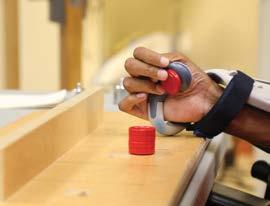
3 minute read
Fundraising, Administrative, and Scientific Support Staff
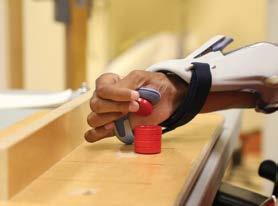
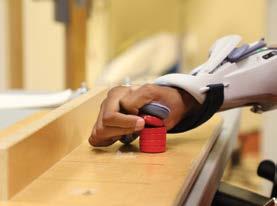
Despite fully paralyzed muscles, the research participant is able to stack chips using hand movements controlled by his own thoughts
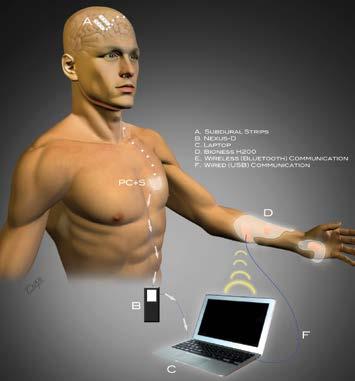
Electrodes on the brain, connected to an implanted control system, communicate wirelessly to enable hand movements
Because the spinal cord carries information from the brain to the muscles, people with SCIs in the high cervical area often do not have the ability to control hand movements. Remarkably, however, the cells in the brain still respond when a person even thinks about moving their hand.
For SCI researchers, the challenge has been trying to read those signals from the brain and bypass the injured spinal cord to achieve movement of paralyzed muscles. In the 1970s, Jacques Vidal, Ph.D., professor emeritus, computer science at UCLA, coined the term “brain-computer interface” as he began exploring ways in which brainwaves could be used to control external devices. Research into human-machine interaction has exploded over the past few decades as scientists from around the world look at ways to use non-invasive and permanently implanted sensors to record brain activity and control everything from screen cursors to robotic arms.
At the Miller School of Medicine, Dr. Jagid worked with Michael Ivan, M.D., assistant professor of neurological surgery and an expert in brain mapping, to stimulate different areas of the brain to identify the precise area which controls the research participant’s dominant right hand. Dr. Jagid and his team then implanted the device over that particular region of his brain.
Following the surgery, the team spent weeks using a sophisticated program to “train” the computer to understand when thoughts of hand movement were observed in the electrical activity from the research participant’s brain. Within milliseconds of a signal being detected, special algorithms determine whether he is thinking about moving his hand. Electrical signals are then sent to an external orthosis that stimulates the research participant’s hand muscles and causes them to open or close, much the same way that his body did before injury.
With the brain-machine interface, Dr. Jagid said, the research participant is now able to successfully pick up and transport objects with his right hand.
“What is unique here is that nobody before has used this particular fully implanted device in an attempt to help a person with SCI achieve some restoration of function that can be used in a meaningful way outside of the lab setting,” Dr. Jagid said. “Other devices that have achieved similar results require the person to have an implanted post protruding from the head and be tethered to a computer in a lab.”
Dr. Jagid and his team hope that, in the not too distant future as technologies such as this evolve, the effect of a devastating SCI can be minimized, giving people with SCI the ability to live more independently.
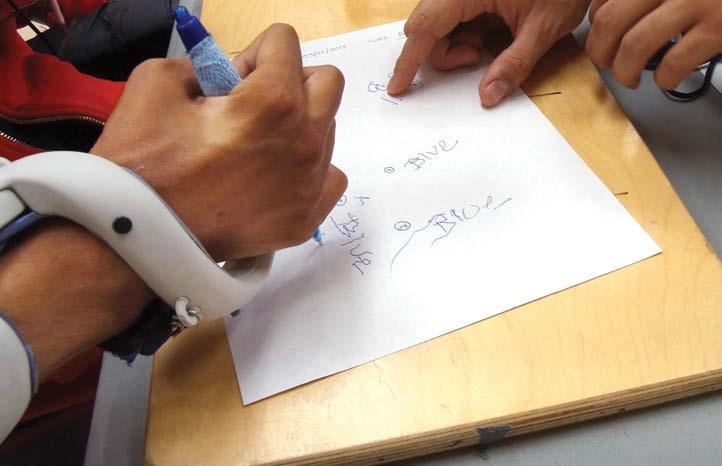
Thanks to the brain-machine interface, the participant is able to write and even control a robotic walking system using signals from his brain
Joining Drs. Jagid and Prasad for this clinical trial are Iahn Cajigas, M.D., Ph.D., Resident, Department of Neurological Surgery; Noeline Prins, Ph.D., Postdoctoral Research Associate, Department of Biomedical Engineering; Michael Ivan, M.D., M.B.S., Neurosurgeon; Sebastian Gallo and Jasim Ahmad, undergraduate researchers, Department of Biomedical Engineering; Letitia Fisher, research coordinator; Anne Palermo, physical therapist; and Audrey Wilson, research associate.
In their study published in 2018, Dr. Prasad’s team compared the feasibility of decoding movement information from the scalp of uninjured participants and comparing that to people who had suffered a cervical SCI. They found that despite the damage to the spinal cord, the brain signals of both uninjured subjects and SCI participants as recorded from the surface of the scalp contained sufficient information to determine when they wanted to initiate movement with high accuracy. Now with sensors sitting on the surface of the brain, the improved signal quality is already leading to better contol of the device for functional tasks. Gant, K., Guerra, S., Zimmerman, L., Parks, B., Prins, N., & Prasad, A. (2018). EEG-controlled functional electrical stimulation for hand opening and closing in chronic complete cervical spinal cord injury. Biomedical Physics & Engineering Express, 4(6), 065005




